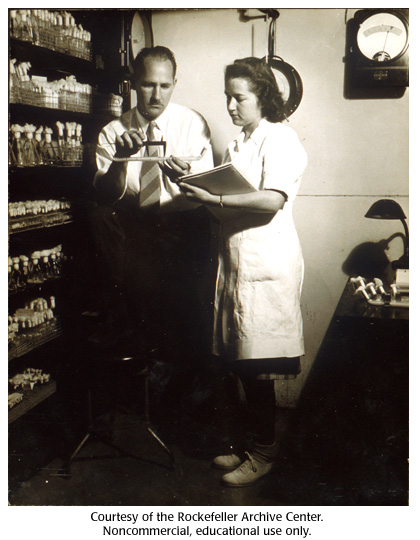Gallery 16: Beadle and assistant in the Neurospora storeroom at Stanford, 1949.

Beadle and assistant in the Neurospora storeroom at Stanford, 1949.
beadle, storeroom, stanford
- ID: 16366
- Source: DNALC.DNAFTB
Related Content
16362. Gallery 16: George Beadle at work in his lab at Stanford.
George Beadle at work in his lab at Stanford.
16371. Biography 16: George Wells Beadle (1903-1989)
George Beadle had successful research careers in corn and Drosophila genetics, before starting the field of Neurospora research.
16361. Gallery 16: Young George Beadle, around 1908.
Young George Beadle, around 1908.
16372. Biography 16: Edward Lawrie Tatum (1909-1975)
Edward Tatum and George Beadle used Neurospora to prove that "one gene makes one protein." Tatum also had a role in starting bacterial genetics.
16365. Gallery 16: The Rockefeller Foundation funded Beadle's experiments.
The Rockefeller Foundation funded Beadle's experiments. This 1943 letter is a progress report Beadle wrote to the Rockefeller President.
16368. Gallery 16: George Beadle at the Nobel Awards ceremonies.
George Beadle at the Nobel Awards ceremonies.
10339. Stanford-Binet Test, Feeblemindedness
Stanford-Binet Test, Feeblemindedness
15711. Patrick Brown
Patrick Brown works with microarrays at Stanford University.
16147. Gallery 1: George Beadle, 1914
Young George Beadle (1958 winner of the Nobel Prize for Medicine), with his father and sister, 1914.
16418. Biography 18: Joshua Lederberg (1925-2008)
Joshua Lederberg discovered bacterial recombination and started a new field of research.












